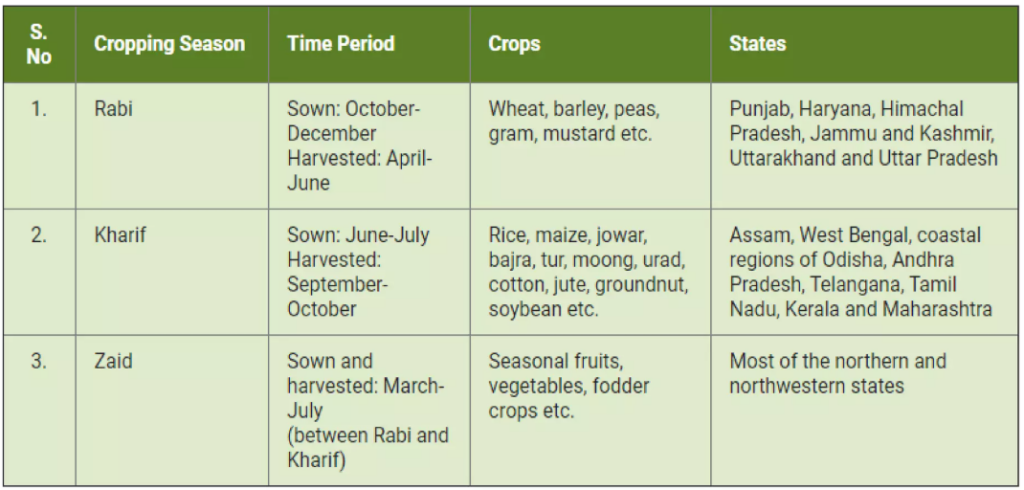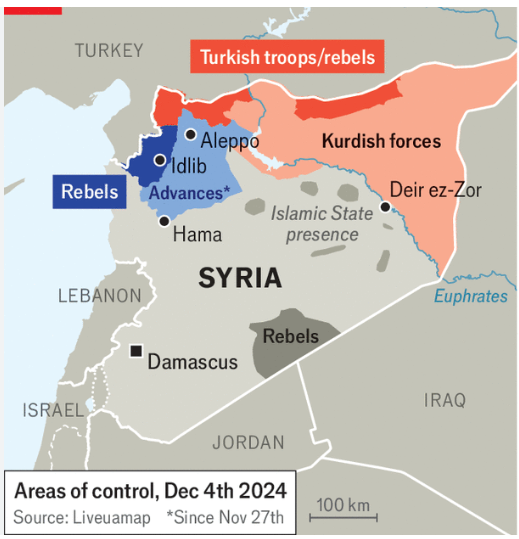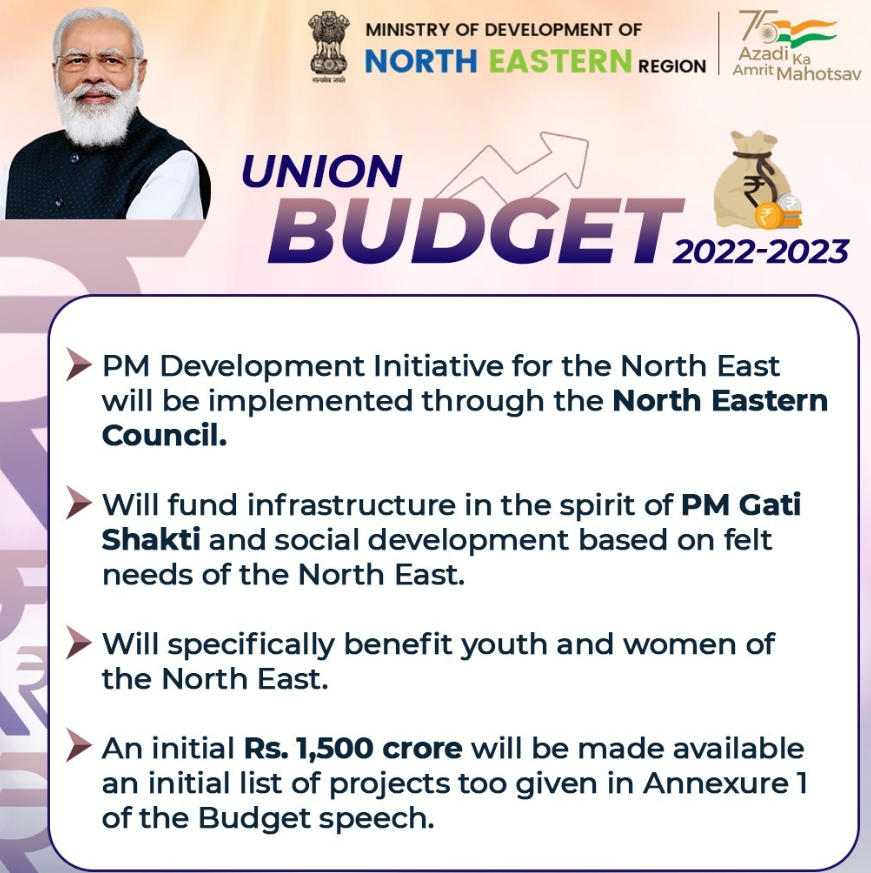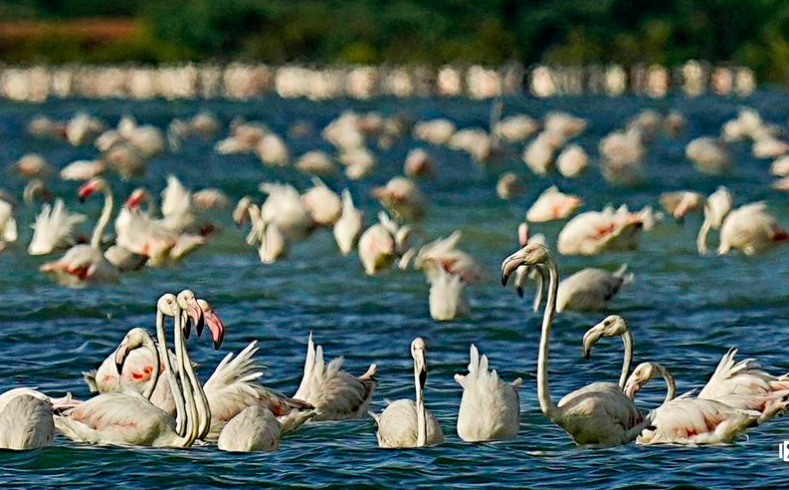6 December 2024 : Daily Current Affairs
1. Potato Price Surge in Odisha: Minister Blames West Bengal for Supply Restrictions Amid Nationwide Crisis
- 1. Potato Price Surge in Odisha: Minister Blames West Bengal for Supply Restrictions Amid Nationwide Crisis
- 2. Rabi Crop Sowing Rebounds Amid Weather and Fertilizer Challenges; Food Inflation Remains a Concern
- 3. Is Syria’s Assad regime in danger?
- 4. At ICJ, India blames developed nations for the climate crisis
- 5. North-East Region Development
- 6. Status Of The Advancement Of Super Computing In India
- PRELIMS FACTS
- 1. Parliament Passes Bharatiya Vayuyan Vidheyak 2024 to Modernize India’s Aviation Sector
- 2. Winged visitors
- 3. PSLV-C59 places PROBA-3 satellites into designated orbit with precision
(Source: Indian Express; Section: Explained; Page: 11)
| Topic: GS3 – Agriculture |
| Context: |
|
Analysis of News:
Potato Production in India
- India is the second-largest producer of potatoes globally, with production primarily concentrated in states like Uttar Pradesh (UP) and West Bengal.
- Together, these two states account for nearly half of the nation’s total potato output.
- However, Odisha’s agro-climatic conditions are unsuitable for potato cultivation, making it heavily reliant on West Bengal for its supply.
- Typically, West Bengal traders send 150–200 truckloads of potatoes daily to Odisha and Chhattisgarh.
Why Prices Are Rising Nationwide
Potato prices have spiked across India, not just in Odisha, due to a combination of seasonal variations and a production decline in the 2023-24 crop year. Key factors include:
- Decline in Production: A 5.6% drop in potato production to 567 lakh metric tonnes in 2023-24 from 601 lakh metric tonnes in 2022-23.
- Reduced Cultivation Area: A marginal decrease in potato cultivation area, particularly in UP and West Bengal, the top producers.
- Low Prices in Previous Years: Farmers planted potatoes on smaller areas due to unprofitable returns in earlier seasons.
- Seasonal Supply Patterns: Prices generally rise in late summer and monsoon due to limited fresh stock.
Impact on Odisha
- While the price surge is a national phenomenon, Odisha feels the brunt more acutely due to its dependency on external supply.
- This reliance exacerbates price volatility when neighboring supplier states, such as West Bengal, prioritize their own markets during shortages.
Economic and Social Implications
The sustained price rise has a direct impact on:
- Household Budgets: As a staple food, potato price inflation disproportionately affects low-income households.
- Inflation Metrics: Potatoes contribute significantly to Consumer Price Index (CPI) and Wholesale Price Index (WPI), influencing overall inflation rates.
- Commercial Sectors: The hospitality and food services sectors face increased input costs, leading to higher prices for consumers.
The Way Forward
Addressing this issue requires:
- Strengthening Storage and Distribution: Odisha could invest in cold storage and streamline supply chains to mitigate supply disruptions.
- Inter-State Cooperation: Greater coordination between potato-producing and consuming states to manage supply during shortages.
- Encouraging Local Cultivation: Initiatives to experiment with heat-tolerant potato varieties in Odisha to reduce dependency on imports.
- Price Stabilization Measures: Expanding government procurement and creating buffer stocks to stabilize prices during production shortfalls.
The crisis highlights the need for long-term planning to ensure food security and price stability for essential commodities like potatoes.
| About Potato crop |
|
| Practice Question: Examine the factors contributing to the recent surge in potato prices in India, with a focus on Odisha’s dependency on external supplies. Discuss the economic and social implications of such price volatility and suggest measures to ensure food security and price stability. (250 words/15 m) |
2. Rabi Crop Sowing Rebounds Amid Weather and Fertilizer Challenges; Food Inflation Remains a Concern
(Source: Indian Express; Section: Explained; Page: 11)
| Topic: GS3 – Agriculture |
| Context: |
|
Analysis of News:
Fertilizer Shortages and Their Consequences
- The scarcity of di-ammonium phosphate (DAP) fertilizer compounded the challenges for farmers.
- DAP, essential for early root development, was in lower supply compared to the previous year, forcing farmers to delay sowing or rely on less effective alternatives.
- This shortage raised concerns about potential impacts on crop growth and yields, especially for wheat and potatoes.
Recovery and Positive Indicators
Despite early setbacks, the situation improved after mid-November:
- Increased Water Availability: A surplus monsoon filled reservoirs to 86.7% of their capacity, well above historical averages, ensuring ample irrigation for rabi crops.
- Normalizing Temperatures: Seasonal temperatures returned to normal, aiding late sowings.
- La Niña Influence: A developing La Niña event is expected to bring a prolonged winter, potentially mitigating the effects of late sowing and boosting yields, particularly for wheat.
Current Sowing Trends
- Updated data shows recovery in wheat, chana, and masoor acreages, surpassing last year’s levels.
- However, mustard sowing continues to lag, reflecting the lasting impact of unfavorable weather and delayed sowing windows.
Food Inflation and Economic Outlook
- High food inflation, driven by disrupted vegetable supplies and lower wheat stocks, remains a concern.
- Potato and edible oil prices are expected to stay elevated due to weather-related production challenges and global market dynamics.
- On the other hand, inflation in pulses and vegetables is likely to moderate with improved supplies from winter harvests.
Policy Implications
- The government may consider reducing import duties on wheat and edible oils to stabilize domestic prices, especially as wheat stocks approach the normative minimum.
- These measures, coupled with La Niña-induced favorable weather, could ensure a better rabi harvest and ease food inflation in the coming months.

| Practice Question: Discuss the challenges faced by Indian farmers during the 2024 rabi sowing season due to high temperatures and fertilizer shortages. Evaluate the measures needed to mitigate such disruptions and ensure stable food production and inflation control. (250 words/15 m) |
3. Is Syria’s Assad regime in danger?
(Source – The Hindu, International Edition – Page No. – 10)
| Context |
|

Renewed Conflict in Syria
- Islamist militants launched a surprise offensive in northwest Syria, capturing key territories, including Aleppo.
- This marks the resumption of active conflict after a relative calm since 2016.
Shift in Territorial Control
- Prior to Russia’s intervention in 2015, the Assad regime controlled only Damascus and coastal cities.
- Post-2016, the regime regained territories with Russian and Iranian support, pushing militants into Idlib.
- Last week’s offensive allowed militants to more than double their territorial holdings, including Aleppo and parts of Hama.
Key Actors in the Conflict
- The Regime: Backed by Russia, Iran, and Shia militias, it seeks to retain control.
- Syrian Democratic Forces (SDF): Kurdish militias backed by the U.S., controlling northeast Syria.
- Hayat Tahrir al-Sham (HTS): A jihadist group leading the current offensive, along with the Syrian National Army (SNA).
HTS: A Leading Militant Group
- HTS evolved from al-Qaeda’s Syrian branch, led by a U.S.-designated terrorist.
- It controls Idlib and has declared its fight against the Assad regime, not the U.S.
Geopolitical Factors Driving the Offensive
- Russia’s focus on Ukraine and reduced presence in Syria weakened regime support.
- Iran and Hezbollah, key allies of Assad, are overstretched or weakened due to external conflicts and airstrikes.
- Turkey reportedly backed the militants, exploiting the regime’s vulnerabilities.
Implications for the Future
- Rebel advances signal a potential resurgence of civil war across Syria.
- Regime forces are regrouping with reinforcements from Iraqi militias, but prolonged bloodshed is likely.
4. At ICJ, India blames developed nations for the climate crisis
(Source – The Hindu, International Edition – Page No. – 4)
| Context |
|
India’s Stance at the ICJ on Climate Crisis
Developed Countries’ Role in the Crisis
- India criticized developed countries for their historical contribution to the climate crisis.
- India stated that these countries exploited the global carbon budget and failed to fulfill their climate finance promises.
- Despite their minimal contribution to global emissions, developing countries are bearing the brunt of climate change impacts.
Unequal Responsibility for Climate Degradation
- India emphasized that responsibility for climate change should be distributed equally, considering the unequal contribution to global degradation.
- India stressed that those who have benefited the most from fossil fuel usage are now discouraging developing nations from utilizing their own energy resources for growth.
Climate Finance Commitments Unfulfilled
- India highlighted the failure of developed countries to honor climate finance commitments, particularly the $100 billion pledge made at the Copenhagen COP in 2009.
- The new climate finance package from COP29 was criticized as insufficient and distant, failing to address the immediate needs of the Global South.
Commitment to Climate Targets with Caution
- India reaffirmed its commitment to the Paris Agreement but expressed concerns about overburdening its citizens.
- The country emphasized the need to balance climate action with the socio-economic realities of sustaining one-sixth of the global population while pursuing Sustainable Development Goals.
| International Court of Justice |
|
Principal judicial organ of the United Nations: Settles legal disputes between states and gives advisory opinions on legal questions referred to it by authorized UN organs and specialized agencies. Located in The Hague, Netherlands: Known as the “World Court,” it is the successor to the Permanent Court of International Justice. 15 Judges: Elected to nine-year terms by the UN General Assembly and Security Council. Two types of cases: Contentious cases between states and advisory proceedings on legal questions. Judgments are binding: However, the ICJ has no way to enforce its decisions. Official languages: English and French. These languages are used for the court’s proceedings, documents, and communications. |
| Practice Question: Discuss the implications of the International Court of Justice’s examination of legal obligations on climate change. How does India’s stance on climate finance and the burden on developing nations reflect global challenges in addressing climate change? (150 Words /10 marks) |
5. North-East Region Development
(Source – https://pib.gov.in/PressReleseDetail.aspx?PRID=2081098®=3&lang=1 )
| Context |
|
The PM-DevINE scheme focuses on infrastructure and social development in the Northeast Region (NER), promoting holistic growth through Central funding. Complementing it, the UNNATI initiative supports industrialization, employment generation, and resilience, fostering inclusive development in the region. |

PM-DevINE Scheme Overview
- Announced in the Union Budget 2022-23 as a Central Sector Scheme with 100% Central funding.
- Initial outlay of ₹1,500 crore, later increased to ₹6,600 crore for FY 2022-23 to FY 2025-26.
- Objectives:
- Funds infrastructure projects aligned with PM Gati Shakti.
- Supports social development initiatives based on the needs of the North East Region (NER).
- Promotes livelihood activities for youth and women.
- Addresses development gaps in various sectors.
- Progress:
- 35 projects worth ₹4,857.11 crore sanctioned as of November 2024.
Industrialization Initiatives in NER
- North East Industrial Development Scheme (NEIDS):
- Launched in 2017 and ended on March 31, 2022.
- Aims at promoting industrialization in NER.
- Uttar Poorva Transformative Industrialization Scheme (UNNATI) Scheme:
- Launched on March 9, 2024.
- Focuses on enhancing infrastructure, employment, and regional prosperity.
- Incentives provided:
- Capital Investment Incentive.
- Capital Interest Subvention.
- Manufacturing & Services Linked Incentive.
Budgetary Allocation for NER Development
- Non-exempt Union Ministries/Departments are required to allocate 10% of their Gross Budgetary Allocation for NER.
- Provisional expenditure of ₹3,53,412 crore incurred between 2019-20 and 2023-24.
| PYQ: Cross-border movement of insurgents is only one of the several security challenges facing the policing of the border in North-East India. Examine the various challenges currently emanating across the India-Myanmar border. Also, discuss the steps to counter the challenges. (250 words/15m) (UPSC CSE (M) GS-3 2019) |
| Practice Question: Discuss the role of schemes like PM-DevINE and UNNATI in addressing developmental challenges in the Northeast Region. How do such initiatives contribute to regional industrialization and socio-economic growth? (250 Words /15 marks) |
6. Status Of The Advancement Of Super Computing In India
(Source – https://pib.gov.in/PressReleseDetail.aspx?PRID=2081061®=3&lang=1 )
| Context |
|
National Supercomputing Mission (NSM)
- Jointly implemented by the Department of Science and Technology (DST) and Ministry of Electronics and Information Technology.
- Achievements:
- 33 supercomputers with a total capacity of 32 PetaFlops established at 24 locations nationwide.
- Institutions housing supercomputers include IITs (e.g., Gandhinagar, Goa, Kanpur, Madras), IISc, NIT Trichy, and others.
- ₹1,874 crore allocated/utilized for infrastructure, R&D, applications, HRD, and mission management.
- Expansion plan includes adding 20 PetaFlop systems to select institutions.
- Human Resource Development:
- Over 20,000 individuals trained through five training centers located in Pune, Kharagpur, Chennai, Palakkad, and Goa.
National Quantum Mission (NQM)
- Objectives:
- Develop intermediate-scale quantum computers with 50–1,000 physical qubits within 8 years.
- Platforms include superconducting and photonic technologies.
- Key Initiatives:
- Four Thematic Hubs (T-Hubs) established for technology, HRD, entrepreneurship, and international collaboration in quantum computing.
National Mission on Interdisciplinary Cyber-Physical Systems (NM-ICPS)
- 25 Technology Innovation Hubs (TIHs) established in advanced technology verticals, including quantum computing.
Significance
- Enhances India’s capabilities in supercomputing, quantum technology, and cyber-physical systems.
- Boosts R&D, innovation, and global collaborations while creating a skilled workforce.
| Practice Question: Examine the role of initiatives like NSM, NQM, and NM-ICPS in strengthening India’s technological capabilities. How do these missions contribute to research, innovation, and human resource development in advanced technology domains? (150 Words /10 marks) |
PRELIMS FACTS
1. Parliament Passes Bharatiya Vayuyan Vidheyak 2024 to Modernize India’s Aviation Sector
(Source: Indian Express; Section: In Parliament; Page: 08)
| Context: |
|
Analysis of News:
Need to Replace the Aircraft Act 1943:
- The Act has been amended several times to enhance safety, oversight, and to meet requirements for sustainable growth of the aviation sector and to give effect to the provisions of international conventions.
- As a result of numerous amendments, a need is felt to address the ambiguities and confusion experienced by the stakeholders,
- To remove redundancies,
- To simplify processes and improve ease of doing business,
- To provide for design, manufacture, and maintenance of aircraft and related equipment.
Objectives of the Bhartiya Vayuyan Vidheyak Bill 2024:
- The legislation will bring the Radio Telephone Operator Restricted (RTR) Certificate and Licence testing process from the Department of Telecom (DoT) to the Directorate General of Civil Aviation (DGCA).
- This would ease the process for pilots as they can secure all their certificates from one authority.
- Empower the Central Government –
- To make rules to implement the Convention relating to international civil aviation and other matters relating to civil aviation security.
- To issue orders in emergencies in the interest of public safety or tranquility.
- Provide for payment of compensation for loss or damage in such manner as provided under the Act.
- Provide for appeals against matters relating to compensation, licenses, certificates, or approvals, and adjudication of penalties.
- Provide for imprisonment, fines, or penalties for contravention of the provisions of the Act or the rules made thereunder.
What are the Major Additions in the Bhartiya Vayuyan Vidheyak Bill 2024?
- The government has changed the definition of what qualifies as an aircraft, with balloons and gliders removed.
- The Bill empowers the Central Government to make rules –
- Regulating the design, manufacture, maintenance, possession, use, operation, sale, export, or import of any aircraft or class of aircraft and
- For securing the safety of aircraft operations.
- The new bill has given more powers to the DGCA, the Bureau of Civil Aviation Security (BCAS), and the Aircraft Accident Investigation Bureau (AAIB) over the safety of the aviation environment in the country.
- It empowers the Central Government or any officer to suspend, cancel, or restrict any license or certification granted under the Act.
- However, an opportunity for hearing must be given to the affected party prior to passing such an order.
- A concept of second appeal against such an order has also been added.
- So earlier there was one appeal and then a final appeal to the Secretary MoCA.
- Now an interim appeal in between has been added.
2. Winged visitors
(Source – The Hindu, International Edition – Page No. – 3)
| Context |
|

About Greater Flamingo:
- Physical Characteristics: Tall wading birds with pinkish plumage, long necks, and legs. The color comes from their diet of algae and crustaceans.
- Conservation Status: Least Concern (IUCN), but face threats like habitat loss and pollution.
- Species Diversity: Six recognized species, with the Greater Flamingo and Lesser Flamingo most commonly found in India.
- Diet: Feed on algae, diatoms, and small aquatic organisms, using their specialized beaks to filter food.
- Habitat: Prefer shallow water bodies like lagoons, estuaries, and salt pans.
- Behavior: Highly social, they form large flocks to feed and breed.
- Breeding: Build mud mound nests and lay a single egg.
- Significance: Indicators of wetland health, they attract ecotourism and contribute to biodiversity.
- Migration to India: Flamingos migrate to India during winter, seeking favorable feeding and breeding conditions in wetlands like Pulicat Lake and Rann of Kutch.

3. PSLV-C59 places PROBA-3 satellites into designated orbit with precision
(Source – The Hindu, International Edition – Page No. – 4)
| Context |
|

PROBA-3: Key Information
- Purpose: Designed to create artificial solar eclipses, enabling prolonged studies of the Sun’s corona, the outermost layer of its atmosphere.
- Agency: The European Space Agency (ESA) oversees PROBA-3.
- Spacecraft Configuration: Comprises two spacecraft launched together that separate in orbit to function as a single unit through coordinated flying.
- Technological Advancement: Demonstrates formation flying with millimeter precision, a significant step for future multi-satellite missions.
- Launch Details: Successfully launched aboard ISRO’s Polar Satellite Launch Vehicle-C59 from Satish Dhawan Space Centre, Sriharikota.
- Orbit Operations: Initial commissioning will last several months, with operational observations expected to begin in about four months.
- Significance: Paves the way for advanced in-orbit demonstrations, enhancing capabilities for astronomical studies and future space missions.
